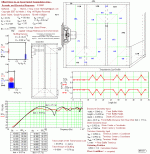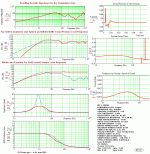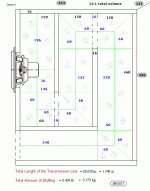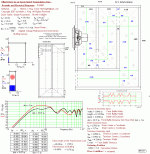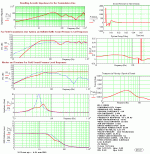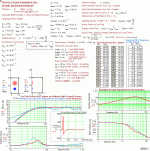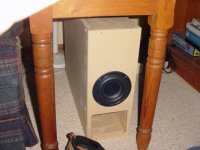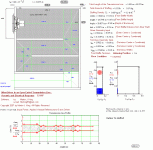I like to design a small subwoofer using the Tang Band W5-1138SM,
pictured here: http://www.partsexpress.com/pe/showdetl.cfm?&Partnumber=264-831
I will be using it mainly for listening to music, classical, jazz etc. I am very interested in mating it with my Cyburg Needles here:
http://www.diyaudio.com/forums/showthread.php?s=&threadid=99154
I like to have a stylish subwoofer (if possible) and details of cabinet if someone can help, thanks,
gychang
pictured here: http://www.partsexpress.com/pe/showdetl.cfm?&Partnumber=264-831
I will be using it mainly for listening to music, classical, jazz etc. I am very interested in mating it with my Cyburg Needles here:
http://www.diyaudio.com/forums/showthread.php?s=&threadid=99154
I like to have a stylish subwoofer (if possible) and details of cabinet if someone can help, thanks,
gychang
check this thread ...
if size is not a major issue. DJK discribes such a sub for a five inch unit well toward the end of the thread about 18 pages in.
http://www.diyaudio.com/forums/showthread.php?s=&threadid=9501&highlight=
if size is not a major issue. DJK discribes such a sub for a five inch unit well toward the end of the thread about 18 pages in.
http://www.diyaudio.com/forums/showthread.php?s=&threadid=9501&highlight=
Re: check this thread ...
Moray, thanks but can't seem to locate it.
gychang
moray james said:if size is not a major issue. DJK discribes such a sub for a five inch unit well toward the end of the thread about 18 pages in.
http://www.diyaudio.com/forums/showthread.php?s=&threadid=9501&highlight=
Moray, thanks but can't seem to locate it.
gychang
This the only mention of the W5 that I could find in that thread:
http://www.diyaudio.com/forums/showthread.php?postid=1035637#post1035637
http://www.diyaudio.com/forums/showthread.php?postid=1035637#post1035637
Theli said:This the only mention of the W5 that I could find in that thread:
http://www.diyaudio.com/forums/showthread.php?postid=1035637#post1035637
thanks Theli, is there a calculator for sub building cabinet software on the internet?
thanks,
gychang
Page 19 I think....
djk []
diyAudio Member
Offline
Registered: Feb 2001
Location: USA
Post #185
"Ok, I can't hold it in anymore. I want to build one of these things. I have an orphaned (not one of a pair) RadioShack/Optimus 4" driver that has a Fs of 85 Hz, a Qts of 0.62, and a Vas of 0.10 ft^3. It has a decent mechanical excursion limit, and a nice big magnet. Would it be suitable for a waveguide system like the one pictured in Post #7? "
Post #7 just shows a 1/4W trans line. The Sound Cannon would have about 6dB more output and less cone motion, very important where small drivers are used.
For a computer desk system it is quite easy. Use a 20" long by 3" dia pvc pipe in front of the cone. Make a little box for the drver and pipes to fit into. The box hold the driver and acts like a 90* elbow. The box would be at the back left (or right) corner of the desk. A second pipe 40" long goes across the back of the desk into a 90* elbow, and then to the front through another 20" pipe. The whole thing can be hung to the underside of the desktop with a couple of strap hangers, or you could hang it on the wall.
djk []
diyAudio Member
Offline
Registered: Feb 2001
Location: USA
Post #185
"Ok, I can't hold it in anymore. I want to build one of these things. I have an orphaned (not one of a pair) RadioShack/Optimus 4" driver that has a Fs of 85 Hz, a Qts of 0.62, and a Vas of 0.10 ft^3. It has a decent mechanical excursion limit, and a nice big magnet. Would it be suitable for a waveguide system like the one pictured in Post #7? "
Post #7 just shows a 1/4W trans line. The Sound Cannon would have about 6dB more output and less cone motion, very important where small drivers are used.
For a computer desk system it is quite easy. Use a 20" long by 3" dia pvc pipe in front of the cone. Make a little box for the drver and pipes to fit into. The box hold the driver and acts like a 90* elbow. The box would be at the back left (or right) corner of the desk. A second pipe 40" long goes across the back of the desk into a 90* elbow, and then to the front through another 20" pipe. The whole thing can be hung to the underside of the desktop with a couple of strap hangers, or you could hang it on the wall.
velmerand42,
Here is an example of a folded 27.3 L TL with the W5-1138SM.
Any larger dimensioning like CSA=2 x Sd and length will work even better as this TL has minimum CSA and length.
b
1(2)
I was actually thinking of making a folded TL sub out of one of those so I could have a smaller sub since I'm moving into a condo. Anybody done the calculations on Martin's sheets for that one?
Here is an example of a folded 27.3 L TL with the W5-1138SM.
Any larger dimensioning like CSA=2 x Sd and length will work even better as this TL has minimum CSA and length.
b
1(2)
Attachments
…Sorry but I just don't see the point of a 25+ litre box using a 5 inch drive unit. You can fit an 8 inch unit in that space and annailhate any 5 inch…
Who requested a ported design?
When I post an answer I try to stay with the identified question and keep the subject by showing examples instead of diverting perpendicular every time a question is put at this DIY forum.
My answers is not about whether this is a good design or not using the TB W5-1138SM in a TL and I’m not judging the questioner if his request is outrageous bad.
Where’s your superior ported design? Here is one sample of mine, now show us yours!
b
1(1)
Attachments
Hey calm down. I was just offering the suggestion that such a big box was not a good solution IMO. I see it as helpful if you point out that there is a potentially better alternative, rather than let somebody potentially make a mistake, just because they didn't ask that.
I see that you were just responding to the mentions of doing a TL, I was just commenting on getting the best result, not digging at you.
Now that you have posted a good vented design it's job done as far as I'm concerned, I'm not trying to compete with you.
I see that you were just responding to the mentions of doing a TL, I was just commenting on getting the best result, not digging at you.
Now that you have posted a good vented design it's job done as far as I'm concerned, I'm not trying to compete with you.
Hey, all.
It was me that designed that sub for the W5. That isn't a classical transmission line by any means. Instead, it's a relatively newer design called a Decoupled Antiresonant Line, or Daline. There's virtually no published theory except for rules of thumb which describe an unstuffed quarter-wave line with a 'decoupling chamber' between the driver and the line, whose volume is equal to a typical sealed enclosure for that driver. Drivers with low Qts work best. The recommended tuning of the line is around 0.707Fs. The results I've achieved from my Daline subwoofer are impressive, especially in my open-plan house, though I think I could have still benefited from using MJK's Mathcad worksheets to optimize the enclosure. I get the feeling that woofer excursion isn't controlled as well as it could be in my Daline, so that's something that could be optimized using the MJK worksheets.
If you need an enclosure that can provide enthusiastic resonant augmentation to your woofer, definitely take the Daline concept for a spin -- use the rules of thumb that I detailed above as a starting point.
It was me that designed that sub for the W5. That isn't a classical transmission line by any means. Instead, it's a relatively newer design called a Decoupled Antiresonant Line, or Daline. There's virtually no published theory except for rules of thumb which describe an unstuffed quarter-wave line with a 'decoupling chamber' between the driver and the line, whose volume is equal to a typical sealed enclosure for that driver. Drivers with low Qts work best. The recommended tuning of the line is around 0.707Fs. The results I've achieved from my Daline subwoofer are impressive, especially in my open-plan house, though I think I could have still benefited from using MJK's Mathcad worksheets to optimize the enclosure. I get the feeling that woofer excursion isn't controlled as well as it could be in my Daline, so that's something that could be optimized using the MJK worksheets.
If you need an enclosure that can provide enthusiastic resonant augmentation to your woofer, definitely take the Daline concept for a spin -- use the rules of thumb that I detailed above as a starting point.
Attachments
Taterworks, interesting concept. I've never heard of a DAline before, I'll have to look into it. The enclosure is pretty large though, my 8" Dayton DVC enclosure is ~45L. I was hoping for a tall, narrow baffle, folded tapered line enclosure of fairly low volume. I don't have Martin's sheets yet, so hadn't had a chance to run any calcs.
I'll probalby lay down the $25 to get a copy of his latest sheets and toy around with them, but not until after I move into my new place this weekend.
Oh yes, and apologies to gychang, I seemed to have completely derailed the thread from his original line of inquiry (although what I have in mind could be pretty much on par with what he asked for).
I'll probalby lay down the $25 to get a copy of his latest sheets and toy around with them, but not until after I move into my new place this weekend.
Oh yes, and apologies to gychang, I seemed to have completely derailed the thread from his original line of inquiry (although what I have in mind could be pretty much on par with what he asked for).
I feel that a real strength of my design is its completely endfiring design, where it can be tucked behind something like a sofa or an entertainment center, and there will be no worry of blocking a side-firing woofer. The Daline generates plenty of output, and there's definitely an output-for-compactness tradeoff here, but I think the Daline design gives you plenty of options for the form factor of your box, while if you used a larger driver, you'd simply need to make a big rectangular box. A slim, endfiring design would be much more difficult without the Daline's ability to produce more output from small bass drivers. I think that with your transmission line design, you'll be throwing away some of the back wave of the driver, which can be used to do useful work instead. This is because the line of a transmission line is stuffed, while the line of a daline is unstuffed (though the main chamber may be tweaked with stuffing).
There's virtually no published theory…
No need for an especially elaborate theory, its already completely covered by any ported theory that includes the acoustics of a folded line like MJK: s quarter wave papers does and simulation programs do as well.
The Daline generates plenty of output, and there's definitely an output-for-compactness tradeoff here…
In the perspective of Thiele/Small volume/efficiency/cut-off relation: ” nO = Kn x Vb^3 x F3” Its easy to demonstrate that a folded compact ML-TL is the real winner over a Daline (a folding takes volume but many more means more internal volume loss too) because it uses a larger internal volume for the same cabinet gross dimensions and a comparatively smaller port to achieve a lower cut-off frequency, a wider bandwidth, a smoother FR, a higher LF sensitivity, a better transient response and a lower group delay.
I'll probably build a daline and a tapered TL for comparison...
Yes why not, and post your findings here at the DIY forum.
More simulations also covering the Daline approach, See pictures 1(7)-7(7).
b
1(7)
Attachments
- Status
- This old topic is closed. If you want to reopen this topic, contact a moderator using the "Report Post" button.
- Home
- Loudspeakers
- Subwoofers
- cabinet design help for 5 1/4" subwoofer
